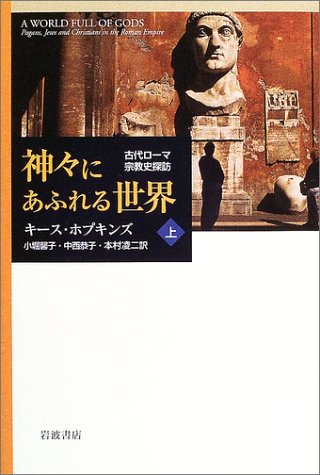55 0 0 0 OA 古代ローマにおける死者祭祀 : レムリア(Lemuria)再考
- 著者
- 小堀 馨子
- 出版者
- 東京大学文学部宗教学研究室
- 雑誌
- 東京大学宗教学年報 (ISSN:02896400)
- 巻号頁・発行日
- vol.28, pp.55-66, 2011-03-31
論文/Articles
4 0 0 0 OA 古代ローマにおける死者祭祀 : パレンタリア(Parentalia)祭考
- 著者
- 小堀 馨子
- 出版者
- 東京大学文学部宗教学研究室
- 雑誌
- 東京大学宗教学年報 (ISSN:02896400)
- 巻号頁・発行日
- vol.27, pp.31-44, 2010-03-31
論文/Articles
3 0 0 0 OA ユダヤ・イスラーム宗教共同体の起源と特性に関する文明史的研究
- 著者
- 市川 裕 佐藤 研 桑原 久男 細田 あや子 高井 啓介 月本 昭男 高橋 英海 菊地 達也 長谷川 修一 葛西 康徳 江添 誠 牧野 久実 小堀 馨子 鎌田 繁 中西 恭子 土居 由美 嶋田 英晴 志田 雅宏 櫻井 丈 小野 塚拓造 山野 貴彦 アヴィアム モルデハイ
- 出版者
- 東京大学
- 雑誌
- 基盤研究(A)
- 巻号頁・発行日
- 2013-04-01
ユダヤ教の歴史を調べていくと、のちに出現する二つの一神教、キリスト教とイスラーム、を生み出す基盤になっていることがわかる。宗教学の歴史は信仰を基盤とする西欧のキリスト教を宗教の一般モデルとしたため、このモデルから外れる諸要素は関心から外れた。しかし、イスラームとラビ・ユダヤ教はそれぞれ、シャリーアとハラハーを特徴とする啓示法の宗教であり、預言者に啓示された神の意志は、日常生活の行動様式を詳細に規定している。これら一神教の二つの異なる類型がともに古代ユダヤ社会に起源を有することを示して、一神教の歴史全体を動態的に理解する道筋を示すことは、人類の宗教史を考察する上で文明史的意義を持つものである。
3 0 0 0 OA 学生支援におけるチーム援助コーディネーター養成研修についての報告(3)
1 0 0 0 OA 大学初年次教育におけるeラーニング(英語)導入の報告(2)
- 著者
- 小堀 馨子 藤原 敬介
- 雑誌
- 帝京科学大学総合教育センター紀要 総合学術研究 = Bulletin of Center for Arts and Sciences Teikyo University of Science (ISSN:24341355)
- 巻号頁・発行日
- vol.5, pp.37-41, 2022-11-30
1 0 0 0 神々にあふれる世界 : 古代ローマ宗教史探訪
- 著者
- キース・ホプキンズ [著] 小堀馨子 中西恭子 本村凌二訳
- 出版者
- 岩波書店
- 巻号頁・発行日
- 2003
- 著者
- 小堀 馨子
- 出版者
- 東京大学文学部宗教学研究室
- 雑誌
- 東京大学宗教学年報 (ISSN:2896400)
- 巻号頁・発行日
- vol.13, pp.73-86, 1996-03-30
The Augustan Revival refers to the religious policy of the Emperor Augustus who was responsible for restoring traditional religion to his empire. "I restored many traditions of our ancestors" summarizes the intent of his policy, one which promoted the reconstruction of ruined temples, the restoration of moribund rituals, and generated several cults. One such newly established cults of the time was that of Apollo and Mars. Augustus maintained special devotion to Apollo and Mars, and dedicated magnificent temples and splendid ceremonies to each deity throughout his life. There is a deeper meaning of these cults. First, Apollo, who had been a mere god of healing in the republic, was given a new role as protector of peace, justice, law, literature and the arts. Augustus thus used Apollo as a symbol to protect the new world-order over which he ruled. Since Augustus considered Apollo his personal protector, he presented himself as one assisted by Apollo in the restoration of the Golden Age. Second, Mars, too, who had once been, but a god of war and agriculture, was given a new role as avenger to right the unbearable wrongs of the Former order. Augustus used Mars as a symbol to purify a Rome profaned by civil war, and to "restore many traditions of our ancestors" as a means of reestablishing rapport with the gods. Augustus therefore believed that he was standing at a historical turning point, and recognized himself as the creator of a new age. N.B.I, cf. RES GESTAE DIVI AUGUSTI chapter 8.(Loeb No.152 p.359)
1 0 0 0 OA 古代ギリシア・ローマ美術史における「祈り」の図像に関する社会学的考察
- 著者
- 長田 年弘 篠塚 千恵子 中村 るい 河瀬 侑 小堀 馨子 坂田 道生 高橋 翔 田中 咲子 中村 友代 福本 薫 山本 悠貴
- 出版者
- 筑波大学
- 雑誌
- 挑戦的萌芽研究
- 巻号頁・発行日
- 2012-04-01
古代ギリシア・ローマ美術史における、広義の「祈り」(「嘆願」、「崇拝」、「オランス」)図像について、作例を検証した。特にギリシア時代の「嘆願」と、ローマ時代の「オランス」に、女性を「祈り」の主体とする作例数が多いことに着目し、社会的弱者の「祈り」と、道徳等の社会規範との関わりに目を向けた。小堀馨子(古代宗教史)は専門的見地から参加し、「命乞い」などのネガティブな価値判断を与えられた「嘆願」図像が、「敬虔さ」を表すポジティブな「崇拝」および「オランス」図像に転用された現象について検討を行った。期間中に5回の研究例会を開催し、最終的な研究成果に関して報告書を編集、刊行、専門研究者に配布した。
- 著者
- 小堀 馨子
- 出版者
- 人文社会系研究科基礎文化研究専攻
- 巻号頁・発行日
- 2013-05-16
学位の種別: 課程博士
1 0 0 0 IR 古代ローマにおける死者祭祀--レムリア(Lemuria)再考
- 著者
- 小堀 馨子
- 出版者
- 東京大学文学部宗教学研究室
- 雑誌
- 東京大学宗教学年報 (ISSN:02896400)
- 巻号頁・発行日
- no.28, pp.55-66, 2010
論文/ArticlesThe Lemuria was one of two festivals for the dead in ancient Rome, and was held on May 9th, 11th, and 13th. In scholarship, the Parentalia is considered a festival dedicated to ancestral spirits, while the Lemuria, is regarded as a festival for the propitiation of the restless and malevolent dead. These festivals were held on particular days called dies religiosi. The Roman usage of the adjective religiosus does not correspond to the modern term "religious". Rather, in the Roman context, religiosus means "of the dead" or "dedicated to the dead". Therefore, the days called dies religiosi were "the days dedicated to the dead." Furthermore, related to the Lemuria, there is the issue whether it was a festival for the souls of dead ancestors (di Manes) or one for the spirits of the malignant dead (larvae). A close reading of the description of this festival found in Ovid's Fasti shows that, contrary to Ovid, the festival was held for the propitiation of the evil dead. His sympathetic description of the souls of the dead in the Lemuria seems to contradict this conclusion. However, considering Ovid's position as court poet for the first Emperor Augustus, it seems appropriate to conclude that he sought to lessen the negative image of the restless dead in the Lemuria and to make his readers regard them in a way similar to the tragic figure of Remus, one of the heroes of the Roman founding myth. However, Ovid's attempt to connect the Lemuria with the founding myth has to be seen as a failure. All other extant sources related to the Lemuria refer to larvae, or the malevolent dead. In conclusion, the term religiosus carried a meaning that its modern equivalents do not possess, i.e. "of the dead" or "dedicated to the dead". Furthermore, examination of the Lemuria shows that Roman perceptions of the dead were very complex and need further investigation. A careful analysis of Roman perceptions of the dead will also contribute substantially to our understanding of Roman religion in general.
